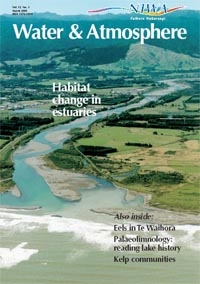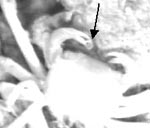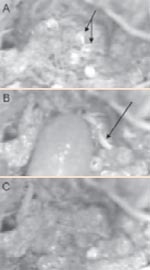PDF of this article (94 KB)

Cindy Baker
Video monitoring is helping to solve the mystery of the diappearing inanga eggs.
The inanga, Galaxias maculatus, is the main species in New Zealand’s recreational and commercial whitebait fishery. Like many fish in the genus Galaxias, inanga lay their eggs on riverbanks. The eggs are deposited amongst intertidal vegetation during spring tides and they are re-immersed only during floods or on the following spring tide. Thus the eggs go through their development out of the water.
One advantage of laying eggs on land is that they are safe from aquatic predators. But a disadvantage is that the eggs gain a whole new set of potential predators, as well as exposure to human impacts.
Management of inanga spawning grounds generally includes fencing off spawning areas to keep out livestock, which otherwise trample eggs and graze on the vegetation protecting the eggs. However, monitoring inanga egg numbers on protected spawning sites has shown that even with fencing in place, significant egg losses still occur. So what is eating them? One suggestion has been that exotic slugs may feed on whitebait eggs, but so far no field studies have confirmed this.
Caught in the act


As part of NIWA’s ongoing research into restoration and enhancement of the whitebait fishery, we used video surveillance of inanga eggs to try to find out why eggs are disappearing from protected spawning sites. We monitored two inanga egg clumps on the Mokau River with infrared cameras. The egg clumps were filmed for 5 seconds at 5-minute intervals throughout a 17-day period in May/June 2003.
A range of invertebrates frequented both sites. There were springtails (small insects) on and around the egg clumps for almost half of the time. Springtails eat fungi and, as eggs were not disappearing, we assumed that the springtails were feeding on fungi or bacteria accumulating on the egg surfaces. Spiders were seen at both sites, but they also presented no danger to the developing larvae. However, two invertebrates were caught in the act, enjoying a taste of caviar.
The first was the common intertidal mud crab, Helice crassa. At one site a crab ate all the developing eggs within an hour and a half. We know that Helice crassa can be quite at home in areas with a strong freshwater influence and they make burrows in surprisingly dry places. This species of mud crab is thought to eat just about anything: decaying organic matter (including dead animal remains), algae of all types, and eggs.
A slug visited the remaining site. In the 5-minute visit, the slug took some eggs but didn’t eat all of them. Some springtails were on the same egg clump, so it is possible that the slug could have been targeting springtails and the eggs were eaten accidentally. This theory complements earlier field studies, which suggested slugs were not major predators of inanga eggs.
This study is ongoing and we plan to continue monitoring inanga eggs with video surveillance in the next spawning season. We will also try to estimate just how many predators there are in a given area at spawning sites.
Teachers: this article can be used for NCEA Achievement Standards in Biology (1.1, 2.1, 2.4, 2.5, 2.9, 3.1, 3.2), Science (2.3), Social Studies (1.4). See other curriculum connections at www.niwa.co.nz/pubs/wa/resources
Cindy Baker is based at NIWA in Hamilton.
Acknowledgements
I thank Ray and Bev Christiansen for help with video maintenance and Josh Smith (NIWA) for assistance throughout the study. This study was funded by the New Zealand Foundation for Research, Science and Technology (Contract C01X0210).
